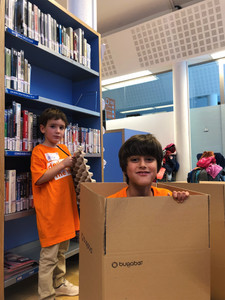Designing the future!
- Irene Cajas
- Nov 20, 2018
- 3 min read
What happens when you let children build their own future? This is the question that Designathon Works is on a mission of finding out.
Founded four years ago in the Netherlands, Designathon Works, has been working to unleash children's creativity and imagination when it comes to facing social challenges and letting them build their own solutions to them. Through their one day (six hours) Global Children's Designathon they provide children with the tools, knowledge and more importantly opportunities to drive innovation and come up with creative solutions to these challenges. Their methodology, based in Design Thinking (a methodology that uses a human-centered, iterative design process consisting of 5 steps—Empathize, Define, Ideate, Prototype and Test) and Maker Education (an approach to problem-based and project-based learning that relies upon hands-on, often collaborative, learning experiences as a method for solving authentic problems) encourages children to be creative and use simple technology to take their ideas and build simple prototypes.
With chapters in various countries around the world, including the Netherlands, Dubai, South Africa, Canada, India, Poland, and Spain, for their 2018 Global Children's Designathon, they brought together over 1000 children between the ages of 8 and 14 to work, develop, and build prototypes for one of the Sustainable Development Goals. As an OpenIDEO Barcelona Chapter Organizer, I was able to participate in the event alongside Judith and other wonderful women. Together our role was to provide support and guidance to the children that had signed up for the event. During the workshop, children were presented with the challenge at hand: deforestation. They also learned about some of the major causes of deforestation in our world and the impacts it has. Once they had a better understanding of the challenge it was time to group them (by age), get to work and watch some magic happen!
Although I had experienced Design Thinking workshops with adults in the past, nothing compares to being able to work with children: their capacity to think outside the box, to imagine without limits, their sense of wonder and their unparalleled enthusiasm are incredibly contagious! As mentors, our first step was to get them to think, learn and question their assumptions about the challenge: What does deforestation mean to you? How does deforestation affect you? Which area of deforestation would you like to address and work on? As they started thinking about the answers to these questions they started sharing their experiences and ideas for potential solutions and moving into the ideation phase. It was in this phase where we began to truly see the extent of their creativity and imagination as they began to dream up possible solutions to a problem that affects us all.
After the groups had drawn up their initial ideas, it was time to create some prototypes. With a whole table of recycled materials, simple electronics and LEDs with button batteries at their hands, they were eager to start building and experimenting with their prototypes. This is where their ideas started to evolve, change and take better form as the materials they chose also influenced their design process. Excited by the opportunities of simple technology, most groups build out machines that would make their ideas a reality; these included machines to build a chemical wood (made from discarded wood), a paper (using discarded fruit peels) making machine, and a machine to quickly plant trees in large areas of deforested land. The last step for these young designers was to present their ideas to their parents, the other children and mentors.
I have to say that in my years in the learning & development field I have had very rewarding moments, especially when adults have these "a-ha moments", but none have been as rewarding as watching as these kids proudly presented their ideas. Ideas they had dreamed up, imagined and worked to create prototypes of, to create a more sustainable future for themselves and others. Some of the most memorable ideas (to me) included the chemical wood, the paper made from fruit peels and a VR grazing pasture for cows, all ideas with tremendous potential and a real chance at changing our future. I could not have spent a better Saturday supporting the work from Designathon Works Spain, whose mission is to truly develop critical thinking, communication, collaboration, digital literacy and design thinking as skills which are becoming even more paramount in our changing and complex future.
















![The brave [me] us](https://static.wixstatic.com/media/4ea088_eac2aa2200a4447a95ceebf633c4b99d~mv2_d_2375_1621_s_2.jpeg/v1/fill/w_980,h_669,al_c,q_85,usm_0.66_1.00_0.01,enc_avif,quality_auto/4ea088_eac2aa2200a4447a95ceebf633c4b99d~mv2_d_2375_1621_s_2.jpeg)


Comments